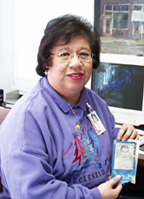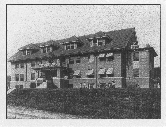 For nearly 60 years, the pages lay forgotten behind a floorboard in the Computing Services Building.
For nearly 60 years, the pages lay forgotten behind a floorboard in the Computing Services Building.
Then, in early February, while remodeling the building’s entryway, workers stumbled across “The Unfolding Story of the Child Saving Institute,” which was housed there from 1911 to 1975.
Despite its nibbled edges, the tri-fold brochure sparked memories for Pat Araujo, who is celebrating her 30th anniversary at UNMC.
“I remember moving into this building and seeing the child-sized drinking fountains and tiny toilets,” said the Information Technology Services coordinator.
For years, the brick building at 619 S. 42nd St. served as an orphanage for thousands of infants and toddlers, as well as a home for unwed mothers. It also served as a nursing school for pediatric nurses and a triage hospital after the 1913 tornado swept through Omaha. George Joslyn pledged $25,000 to build the orphanage if the city would match $50,000. It did, and in 1911 the children moved into a new, spacious home, which was considered the finest child care facility in the country.
Doctors and medical students from UNMC visited daily, donating hours of time for routine health care, as well as surgeries to help those with deformities. Some researched infant care and nutrition issues. In the early 1900s, the Child Saving Institute maintained fully equipped medical facilities including a laboratory, operating room and the only known baby incubator west of Chicago.
In 1953, a three-story addition was built on the north side of the facility. The $100,000 addition included modern laundry facilities, a new kitchen and staff accommodations. At the same time, about $50,000 was spent in remodeling portions of the old building to provide more room for child care and enhance fire safety.
In 1975, UNMC acquired the property and did some interior renovations. Today, it houses Information Technology Services for UNMC and NHS.
Although undated, the brochure mentions serving 154 children in the institute between July 1, 1943 and June 30, 1944. “Great pressure upon us to care for neglected, abused and abandoned babies!” begins an introductory message from Superintendent Alice H. Scott. The brochure seeks contributions of $7 a week, $25 a month or $300 a year.
Araujo, who has a degree in history and geography from then Kearney State College, is grateful the brochure wasn’t discarded. The black and white photos of little round faces, as well as the words — “Wilma is our little deaf and dumb girl. She is three,” — reflect the history and language of the building and society’s past, she said.
The Child Saving Institute, now located at 115 S. 46th St., celebrates its 110th anniversary this year.